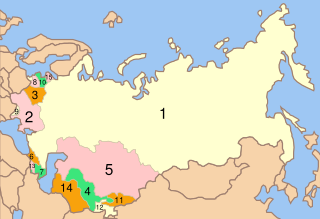 W
WOn July 18 1970, an Antonov An-22 of Soviet Air Forces crashed in the Atlantic Ocean between Iceland and Greenland, while on its way to Halifax, Canada. It was the first crash of the Antonov 22 model and it resulted in the deaths of all 22 people on board.
 W
WThe Soviet Union's 1970 nuclear test series was a group of 16 nuclear tests conducted in 1970. These tests followed the 1969 Soviet nuclear tests series and preceded the 1971 Soviet nuclear tests series.
 W
WAeroflot Flight 244 was hijacked on 15 October 1970, making it the first known successful airline hijacking in the Soviet Union.
 W
WAeroflot Flight 1661 was a passenger flight operated by an Antonov An-24 that crashed during its initial climb, 25 minutes after take-off from Tolmachevo Airport on 1 April 1970. All 45 people on board perished. An investigation revealed that the Antonov collided with a radiosonde, causing a loss of control.
 W
WAeroflot Flight 3630 was a regularly scheduled passenger flight operated by Aeroflot from Mineralnye Vody Airport to Vilnius Airport with a stop over at Rostov-on-Don Airport. On 2 September 1970, the Tu-124 operating this flight crashed after a loss of control at cruise altitude, 42 minutes after take off from Rostov-on-Don Airport. All 32 passengers and five crew members were killed.
 W
WAeroflot Flight U-45 was a passenger flight operated by an Ilyushin Il-18 that crashed during the approach to Samarkand on Friday, 6 February 1970, resulting in the death of 92 of the 106 people on board. An investigation revealed the aircraft went below the minimum obstacle clearance altitude (MOCA) during approach to Samarkand International Airport.
 W
WThe Soviet Census conducted in January 1970 was the first census held in Soviet Union (USSR) in eleven years.
 W
WHMS Ark Royal (R09) was an Audacious-class aircraft carrier of the Royal Navy and, when she was decommissioned in 1979, was the Royal Navy's last remaining conventional catapult and arrested-landing aircraft carrier. She was the first aircraft carrier to be equipped with angled flight deck at its commissioning; her sister ship, HMS Eagle, was the Royal Navy's first angle-decked aircraft carrier after modification in 1954. Ark Royal was the only non-United States vessel to operate the McDonnell Douglas Phantom at sea.
 W
WThe Dead Mountaineer's Hotel is a 1970 Soviet science fiction novel written by brothers Arkady and Boris Strugatsky. In 2015, Melville House published an English translation by Josh Billings as part of their Neversink Library collection. The novel heavily incorporates elements of detective fiction as it follows Inspector Peter Glebsky as he attempts to solve a classic locked-room mystery. However, the novel subverts common mystery novel tropes, and flouts the second of Ronald Knox's "Ten Commandments" of the detective genre:"All supernatural or preternatural agencies are ruled out as a matter of course."
 W
WExhibition of Leningrad artists of 1970 dedicated to 25th Anniversary of Victory over Nazi Germany was opened in Exhibition Halls of the Leningrad Union of Soviet Artists and become one of notable Art Exhibition of 1970 in the USSR.
 W
WThe Hotel Intourist was a hotel in Moscow, Russia. It was built in 1970 as a hotel for foreign tourists to the Soviet Union. In 2002, the hotel was closed and demolished. The Ritz-Carlton Hotel Moscow now stands on the site.
 W
WKosmos 379 was an unmanned test of the LK in Earth orbit.
 W
WLuna 16 was an uncrewed space mission, part of the Soviet Luna program. It was the first robotic probe to land on the Moon and return a sample of lunar soil to Earth. The 101 grams sample was returned from Mare Fecunditatis. It represented the first successful lunar sample return mission by the Soviet Union and was the third lunar sample return mission overall, following the Apollo 11 and Apollo 12 missions.
 W
WLOK Luna 17 was an unmanned space mission of the Luna program, also called Lunik 17. It deployed the first robotic rover onto the surface of the Moon.
 W
WLunokhod 1 was the first of two robotic lunar rovers landed on the Moon by the Soviet Union as part of its Lunokhod program. The Luna 17 spacecraft carried Lunokhod 1 to the Moon in 1970. Lunokhod 1 was the first remote-controlled robot "rover" to freely move across the surface of an astronomical object beyond the Earth. It was also the first wheeled craft on another celestial body. Lunokhod 0 (No.201), the previous and first attempt to do so, launched in February 1969 but failed to reach orbit.
 W
WSoyuz 9 was a June, 1970, Soviet crewed space flight. The two-man crew of Andriyan Nikolayev and Vitaly Sevastyanov broke the five-year-old space endurance record held by Gemini 7, with their nearly 18-day flight. The mission paved the way for the Salyut space station missions, investigating the effects of long-term weightlessness on crew, and evaluating the work that the cosmonauts could do in orbit, individually and as a team. It was also the last flight of the first-generation Soyuz 7K-OK spacecraft, as well as the first crewed space launch to be conducted at night. In 1970, Soyuz 9 marks the longest crewed flight by a solo spacecraft.
 W
WVenera 7 was a Soviet spacecraft, part of the Venera series of probes to Venus. When it landed on the Venusian surface on 15 December 1970, it became the first spacecraft to soft land on another planet and the first to transmit data from there back to Earth.
 W
WZond 8, also known as L-1 No.14, was the last in the series of circumlunar spacecraft, a member of the Soviet Zond program, designed to rehearse a piloted circumlunar flight, an uncrewed version of Soyuz 7K-L1 crewed circumlunar flight spacecraft. The project was initiated in 1965 to compete with the Americans in the race to the Moon but lost its importance once three astronauts circled the Moon on the Apollo 8 mission in December 1968.